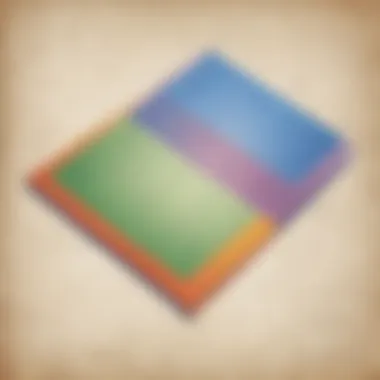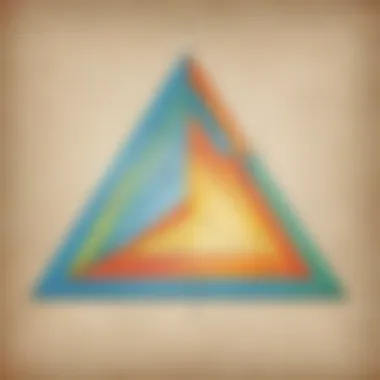Mastering Area Calculations: A Detailed Guide


Intro
Understanding area is a foundational element in mathematics that interweaves through various subjects, from geometry to real-world applications. At its core, the concept pertains to the measurement of space within a defined boundary. For parents and educators, grasping this idea not only enhances their own mathematical toolkit but also equips them to better facilitate their children’s learning. In a world rich with different shapes and sizes, being able to calculate area forms a bedrock for more advanced mathematical concepts.
In this guide, we'll delve into the intricacies of area calculation, elaborate on various shapes and relevant formulas, and present engaging methods to improve comprehension among learners. Rather than just presenting dry facts, we aim to weave a narrative that complements essential math knowledge with practical applications, showcasing how understanding area can come to life in everyday scenarios.
Establishing a strong foundation in the concept of area opens doors to other mathematical principles. For instance, once kids can comprehend how to figure out the area of a rectangle, this can smoothly extend to more complex shapes like triangles and circles. Such a transition allows for an organic growth in their understanding, making math less of a chore and more of an adventure.
From interactive learning games to DIY projects that illustrate the principles of area, this guide aspires to provide a comprehensive set of resources for both teachers and parents. By the end of this journey, you will have a toolkit at your disposal that enhances the richness of mathematical education in a child's life.
Prologue to Area
Understanding area is crucial not only in mathematics but also in various real-life applications. It is the measure of the space contained within a shape and serves as the bedrock for more complex concepts in geometry and other disciplines. As you delve into this article, you will uncover the nuances that make comprehending area fundamental for learners of all ages.
In this section, we'll clarify what area means in a mathematical sense and why learning how to calculate it is essential. From practical occurrences like measuring plots of land to theoretical applications in advanced fields like physics or computer science, the significance of area resonates throughout daily activities and various professions.
Defining Area in Mathematics
So, what exactly is area? In the simplest terms, area is the extent of a two-dimensional surface. It can be visualized as the amount of space that a shape occupies on a flat surface. Mathematically, the area can be represented using specific formulas, tailored for different geometric figures. For instance, the area of a rectangle is calculated by multiplying its length by its width. Therefore, the formula can be written as:
[ \textArea = \textLength \times \textWidth ]
This basic definition serves as a stepping stone for more complex calculations involving various other shapes such as circles or triangles. Understanding this concept lays the groundwork for more advanced mathematical pursuits that students might encounter later in their academic journey.
Importance of Learning Area Calculations
Why is it important to learn about area calculations? The reasons are abundant:
- Real-world applications: From architecture to gardening, knowing how to calculate area helps in making informed decisions. When planning a new garden, you need to calculate how much space the plants will need, or when building a house, knowing the area helps in material estimation.
- Mathematical foundation: Area is foundational in learning more complex concepts like volume and surface area. A strong understanding of area aids in grasping future math lessons.
- Problem-solving skills: Learning to calculate area promotes analytical thinking. Students develop the ability to tackle problems systematically, a skill that serves them well beyond the classroom.
To sum it up, the concept of area will be a recurring theme in various fields and scenarios. Every time we measure a surface, we engage with this mathematical principle without even realizing it. The better we grasp the fundamentals of area, the more equipped we will be to navigate both academic and practical challenges in life.
Mathematical Foundations
The concept of area is not just about numbers and formulas; it forms the backbone of understanding in many mathematical principles. It's crucial to have a firm grasp of the mathematical foundations, as they guide learners from basic calculations to more complex applications. For children, parents, and educators, these foundations serve as a building block, allowing for a smoother progression into advanced topics.
Understanding Dimensions
Dimensions are the fundamental characteristics that shape our spatial understanding. The three key dimensions—length, width, and height—are central to grasping how area functions in various contexts.
Length
Length is the most straightforward dimension, representing how long something is. It's a vital element in calculating area, particularly for shapes like rectangles and squares. The simplicity of length is its charm; it allows learners to visualize and understand the breadth of space they are dealing with. Length is beneficial because it’s primarily intuitively understood, yet it carries the weight of practical applications.
The unique feature of length lies in its versatility. It can range from tiny measurements, like a pencil, to significant scales, like a football field. However, it can sometimes confuse young learners, especially when they encounter differing measurement systems. This confusion highlights the not-so-glamorous side of learning about length, as it requires a keen attention to detail.
Width
Width complements length, filling in the unseen side of shapes. It’s not just a number; width brings depth to our perception of space. In areas involving rectangles, for instance, width is as critical as length when determining how much room exists. By focusing on width, learners pick up that not all spaces are uniformly measured.
What stands out about width is its role in real-world applications—think of constructing furniture or laying out a garden. Knowing how wide a space is helps in his practical tasks. Nonetheless, learners might struggle with width when it blends into overall dimensions. The challenge is to recognize its importance apart from length.
Height
Height introduces the concept of vertical space, which is often overlooked in basic area discussions. It plays an important role, particularly when tackling three-dimensional shapes or considering volume. Height is crucial to understand area in not just a flat context but also how it can extend into the vertical realm.
The standout aspect of height is how it relates to perspective. If a child understands that height can change perception, they can grasp concepts like shadows or perspectives in art. Yet, height can be a tricky element in the early stages of learning about area since many children primarily visualize objects in two dimensions—length and width often overshadow it.
Units of Measurement
Understanding units of measurement is essential for calculating area precisely. It ensures that whenever children express measurements, their base data remains consistent. The common unit for area is square units, and grasping this concept empowers learners.
Square Units
Square units are a way to quantify area based on the squares that cover a given space. This simplicity adds clarity when discussing areas of different shapes, making it easier for learners to visualize the space covered. By using square units, each aspect of measurement becomes a little clearer, as it allows for a direct comparison across various shapes.


The unique feature of square units lies in their adaptability; whether measuring a tiny garden plot or a vast field, the principles remain the same. However, they might be a bit daunting for younger children when they first encounter the term "square unit." With clear explanations and practical visualization, though, this can become a familiar concept.
Conversion between Units
The ability to convert between units is crucial in mathematics. It empowers learners to tackle different scenarios where measurements aren't directly compatible. This skill is not just mathematical but practical, aiding in activities like cooking or construction where various measurement systems may be employed.
What’s key about unit conversion is its role in enhancing flexibility in math. It opens up a broader understanding—children learn that numbers can change magnitude yet still reflect the same concept or area. The downside is that conversions can become tedious, especially with a myriad of different units to remember. Yet, practice alongside real-world applications can solidify this understanding, making all that work worth it.
Finding Area of Common Shapes
Finding the area of common shapes is not just a footnote in geometry; it is truly the backbone of many practical applications in daily life. Knowing how to determine the area of basic shapes empowers individuals to make informed decisions, whether it's planning a garden or constructing a home. This section dives into the specifics of various shapes and their areas, providing invaluable insights and methods that are easy to grasp but rich in application.
Area of a Rectangle
Formula
The formula for the area of a rectangle is straightforward: Area = Length × Width. This simplicity is part of its appeal. It allows for quick calculations, making it a favorite in classrooms and real-world settings alike. The key characteristic of this formula is its universality—rectangle measurements can be taken in various units, and the formula remains effective regardless of whether those units are in meters or inches. This adaptability makes it a popular choice in strengthening mathematical foundations.
The unique feature of this formula is that you can apply it to any rectangle, no matter how large or small. However, while it's advantageous due to its simplicity, one downside might be that it only applies to rectangles—not squares or other polygons.
Practical Examples
When considering practical examples, using the area formula for rectangles is quite beneficial. For instance, if you have a rectangular garden measuring 10 feet in length and 4 feet in width, measuring the area can lead to better planning for plants you wish to grow. The key here is that this practical example concretely shows how abstract math can inform real-life decisions.
One unique feature of practical examples is their ability to contextualize learning. However, a challenge may arise if students cannot relate to the findings in their own lives; hence, teachers must strive to connect concepts to students' experiences, ensuring the relevance of area calculations.
Area of a Square
Formula
The area of a square is determined using a concise formula: Area = Side × Side or simply Area = Side². What stands out here is the elegance of utilizing the same measurement twice. This characteristic introduces a sense of symmetry—making it an engaging concept for learners.
What makes this formula particularly attractive is its straightforwardness: if you know one side's length, you can quickly compute the area. However, one downside might be that it requires an understanding that all sides of a square are equal, which can be confusing for those new to geometry.
Visualizing the Area
Visualizing the area of a square can significantly enhance understanding. This often involves creating a mental picture or using physical models, like cut-out squares or graph paper. Observing squares in the environment, such as tiles on a floor or a chessboard, provides tangible connections to the concept.
The idea of visualization is beneficial as it not only aids retention but makes the learning process more interactive. However, without proper guidance on visualization techniques, some students may struggle to grasp the significance of this approach, making it crucial for educators to provide adequate support and examples.
Area of a Triangle
Formula
The triangle’s area formula is Area = (Base × Height) / 2. This formula allows one to understand the relationship between the base and height in determining the space within a triangular shape. What distinguishes this formula is its flexibility; it can be applied to various types of triangles—be it right-angled, isosceles, or scalene. This adaptability is beneficial, especially when engaging students with different interests or learning styles.
However, it can be a tad trickier. Students often find it confusing to locate the height, as it is not always apparent. Ultimately, reinforcing these concepts with visuals and specific examples can greatly enhance understanding.
Real-World Applications
The real-world applications of triangle area calculations are astounding. For instance, the triangular plans of road signs or the structures of rooftops are practical scenarios where this knowledge comes in handy. The key feature of these applications is their prevalence in architectural design or urban planning.
Yet, one challenge is ensuring that students see the relevance; applying these examples in lessons can greatly help establish a connection.
Area of a Circle
Formula
For circles, the area is found using the formula Area = π × Radius². The presence of pi (π), an irrational number, adds depth to this mathematical formula. This characteristic not only helps in identifying circular areas but also fosters discussions about pi itself, linking it back to numerical concepts that transcend geometry.
This formula's uniqueness lies in its connection to circles specifically—there isn’t a one-size-fits-all that applies to non-circular shapes as seamlessly. However, the challenge here is understanding the radius, as it may require a visual representation to clarify what that measurement encompasses.
Using Pi in Calculations
Utilizing Pi in calculations extends into numerous fields—like engineering, design, and physics. This showcases the formula’s versatility. The key characteristic of incorporating π is that it allows for a deeper exploration of circles in various contexts, enhancing engagement among learners.


While Pi simplifies calculations for circles, the complexity of irrational numbers can be overwhelming for some students. Offering ways to simplify these calculations, like approximating pi to 3.14 for easier math, can be a helpful technique.
Advanced Area Calculations
Advanced area calculations are pivotal in obtaining not just the numerical outputs for various shapes, but into enhancing spatial understanding and practical application in diverse fields. Whether one is aiming to gauge the land of a peculiar plot or determine the paint coverage needed for a funky mural, these calculations serve as the backbone for decision-making.
The intricacies involved in calculating areas of irregular shapes and composite figures can provide a significant edge in both academic and real-world scenarios. Mastering these techniques equips learners with tools to tackle problems that standard formulas cannot easily address. This section delves into two key methods—calculating the area of irregular shapes through the Grid Method and the Subtraction Method—along with a comprehensive examination of composite figures through simple shape addition.
Calculating the Area of Irregular Shapes
Calculating the area of irregular shapes can seem like a daunting task at first glance. These shapes lack the clear-cut formulas we find in standard geometry, yet they frequently crop up in the real world. The key is in methodical approaches that simplify the complexity.
Grid Method
The Grid Method, also known as the counting squares method, stands out for its straightforward and visual approach. This method involves overlaying a grid onto the irregular shape and determining the area by counting full squares, half squares, and so forth.
- Visual Aid: Since this method is visual, it helps learners better grasp the concept of area as they literally see how the shape fits into the grid.
- User-Friendly: It’s particularly beneficial for students, as they can practice this method easily using graph paper or digital tools.
While the Grid Method boasts many advantages, there are several points to consider:
- Accuracy Challenges: It may not provide perfectly accurate results if the shape being measured has curved edges.
- Time-Consuming: For larger or more complex shapes, it can become quite time-consuming to count squares accurately.
Subtraction Method
The Subtraction Method offers another dimension to area calculations. Here, the technique involves determining the area of a larger, known shape and then subtracting the areas of unoccupied spaces—often referred to as the "holes".
- Direct Calculation: This method facilitates direct calculations, making it a popular choice in architectural and engineering contexts.
- Broad Applications: It’s particularly useful for irregular shapes where sections might work within a larger, recognizable figure, like calculating the area of a field with a pond.
Though effective, the Subtraction Method isn’t without its issues:
- Requires Precise Measurements: Accurate area determination relies heavily on being able to measure and identify the shapes correctly.
- Potential for Miscalculations: Just like in anything with subtraction, there's room for error if one miscalculates the area of the hollowed-out parts.
Understanding Composite Figures
Composite figures combine two or more distinctly defined shapes; understanding how to calculate their area is essential in grasping the wider concept of area.
Adding Areas of Simple Shapes
Adding areas of simple shapes is the bedrock of understanding composite figures. When faced with a complex shape, learners can effectively break it down into simpler, more manageable shapes such as rectangles and triangles and add their areas.
- Simplicity of Application: This approach not only simplifies the calculation but also builds confidence in learners to tackle complex problems in a systematic way.
- Versatility: Students can derive areas of seemingly complicated structures by recognizing that they can be deconstructed significantly.
However, it's not without complications:
- Fragmentation of Shapes: This method necessitates some understanding of how to break shapes down accurately, which could be a stumbling block for beginners.
- Numerical Errors: Adding up multiple areas leaves room for arithmetic errors, particularly in lengthy calculations.
Example Problems
Example problems often serve as invaluable resources in the learning process. They provide practical scenarios that help solidify theoretical understanding. Crafting these example problems allows learners to apply methods like addition and subtraction effectively. This part links directly to real-life applications, contributing to both retention of knowledge and skill enhancement.
- Illustrative Learning: Well-constructed problems can shed light on nuanced aspects of area calculations that pure theory might overlook.
- Engagement: Engaging with real-world applications promotes a deeper understanding as learners relate mathematical concepts back to their environment.
Yet, their effectiveness hinges on proper guidance:
- Need for Guidance: Without the right frameworks, learners may feel overwhelmed by examples that seem unattainable.
- Lack of Variety: Repetitive examples can lead to disengagement and a lack of motivation.
Thus, exploring advanced area calculations not only aids in performing accurate measurements but also fosters analytical thinking and problem-solving skills vital for numerous applications in both academics and everyday life.
Applications of Area in Real Life
Understanding the application of area calculations in the real world is crucial for anyone seeking to grasp the significance of this mathematical concept. Irrespective of the age or background, knowing how to measure area carries many practical benefits in everyday life.
For children, recognizing the importance of area can provide a solid foundation for more advanced math topics in the future. For parents and educators, imparting this knowledge helps develop critical thinking and problem-solving skills. In various fields, accurate area calculations make a difference between success and inefficiency, thus emphasizing the need for thorough understanding.
Area in Construction and Architecture


In the domains of construction and architecture, area calculations are indispensable. Buildings don't just exist; they are constructed on carefully planned designs which are deeply rooted in precision. Understanding the area allows builders to determine the amount of materials needed, as well as overall costs.
For example, when laying a foundation, architects must calculate the area of the base. If the area is miscalculated, it can result in using excess concrete or, on the flip side, insufficient material which can compromise structural integrity. The blueprints for a house include areas for each room. Knowing these measurements guides decisions on how large to make spaces and what furniture will fit.
"Every square foot matters in construction; a miscalculation can mean costly adjustments down the road."
Furthermore, the area plays a role in aesthetics and functionality, too. Balancing open spaces with cozy corners is necessary for making spaces appealing and livable. Ultimately, these calculations ensure safety, beauty, and adherence to regulations in building projects.
Area in Agriculture
In agriculture, area is more than just a number; it's often the key to maximizing yield and productivity. Farmers need to measure the area of their fields to plant the right amounts of seeds or fertilizers. If a field is not measured properly, a farmer might over-plant or under-plant crops, which can lead to waste or insufficient harvests.
The relationship between area and production isn’t just in planting seeds but in managing resources. For instance, the area can help determine how much water is needed for a field during irrigation. If the area is estimated incorrectly, water conservation could be neglected, resulting in wasted resources and higher costs.
Additionally, during land assessments, farmers evaluate their land based on its area to calculate the potential return on investment. For example, a farmer may analyze how many acres will yield a good harvest of corn. If land is under-utilized, this can prompt a reevaluation of crop choices or farming techniques.
Area in Art and Design
Art and design often rely on area for creating compelling visuals. Artists frequently consider area when planning their pieces. The dimensions of a canvas or space for a sculpture dictate how the art will look and the impact it will have on viewers.
For instance, a mural on a large wall requires calculating the area to determine how much paint to buy. If an artist fails to measure, they could end up with a half-finished mural or, conversely, tons of leftover paint. Similarly, graphic designers need to have a clear understanding of area when creating digital art or layouts, ensuring that elements are correctly sized and positioned on a page.
In design, area calculation can influence everything from product packaging to interior layouts. Properly measuring area can enhance usability and attract attention which is especially crucial in marketing
In summary, comprehending area in various fields provides numerous advantages, whether it’s ensuring structural integrity in construction, maximizing harvests in agriculture, or crafting compelling art. It goes beyond the classroom, weaving itself into the fabric of practical life, showcasing the enormous value that area calculations bring.
Teaching Area Concepts to Children
Understanding area is not just a mathematical exercise; it’s like the foundation for building a sturdy house of knowledge. When we introduce children to the concept of area, we're giving them the tools to understand space and measurement in their everyday lives. Grasping area opens doors to various subjects, from geometry to art, and even to practical tasks like gardening or home improvement.
One of the special things about teaching area is its real-world connection. Kids may recognize that their favorite activities—like painting a wall or planting flowers in a garden—are tied to how much space these projects occupy. When lessons are linked to their interests, the barriers between learning and play start to dissolve.
Effective Teaching Strategies
To make area concepts resonate with children, it’s vital to use effective teaching strategies. Here are a few approaches:
- Use Visual Aids: Colorful diagrams, models, and shapes can help children visualize area. For example, using squares or grids on paper transforms abstract numbers into something concrete.
- Incorporate Technology: Utilizing apps and educational software can enhance engagement. Virtual objects that can be resized let kids experiment with area calculations while having fun.
- Encourage Discussion: Allowing children to articulate their understanding fosters deeper comprehension. Discussions can help uncover misconceptions and reinforce learning.
These methods not only make the learning process enjoyable but also cater to different learning styles, ensuring that every child grasps area in a way that suits them best.
Using Hands-On Activities
Hands-on activities often prove invaluable when explaining area. Kids learn best by doing, so why not let them dive right in? Here are a few engaging activities to consider:
- Measuring the Classroom: Provide each child with a measuring tape and let them measure their desks, the blackboard, or even the classroom. Afterward, they can calculate the area for each object. This not only builds math skills but also teamwork and organizational skills.
- Crafting Shapes: Use paper to create various shapes and ask the kids to calculate the area by counting squares or by using formulas. This tangible experience can make the concept of area stick in their minds.
- Garden Planning: If there’s access to an outdoor space, let children plan a garden. They can sketch a layout, measure out the area each plant will occupy, and even plant seeds. This can contribute to vital lessons on responsibility and nature, all while learning math.
These hands-on activities effectively engage children while instilling an understanding of area that extends beyond the confines of the classroom. Each experience not only reinforces theoretical knowledge but also lays the groundwork for practical applications in their daily lives.
"The best way to learn is by doing. Engaging children with activities makes math come alive."
By utilizing effective teaching strategies and incorporating hands-on activities, educators can transform the seemingly abstract concept of area into an engaging adventure. The goal is to spark curiosity and instill a lasting understanding that will serve them well in their educational journeys.
The End
Understanding the concept of area serves as a cornerstone in the field of mathematics. In this article, we've traversed the various dimensions of area, explicating its significance not merely as a mathematical challenge but as an essential life skill. By delving into both basic and more complex shapes, the article has illuminated the pathways through which learners can grasp this topic with clarity and confidence.
Recap of Key Concepts
Throughout our discussion, we have highlighted vital components regarding area calculations:
- Defining Area: We began with foundational definitions, clarifying what area means in a mathematical context.
- Geometrical Shapes: Special attention was given to calculating the area of common shapes such as rectangles, squares, triangles, and circles. Each shape was accompanied by applicable formulas and relatable examples.
- Advanced Techniques: We ventured into more advanced areas, exploring methods for calculating the area of irregular shapes along with composite figures.
- Real-life Applications: Practical applications in fields such as construction, agriculture, and art were thoroughly discussed. These examples underscored how area calculations permeate everyday decisions and designs.
- Teaching Approaches: For educators and caregivers, innovative strategies and hands-on activities were outlined to teach these concepts to children effectively.
By focusing on these key elements, it's clear that mastery of area calculations extends beyond academia and into practical situations, reinforcing its relevance in daily life.
Encouragement for Further Exploration
As we conclude this comprehensive guide, I encourage you to explore the topic of area even further. Consider diving deeper into the history of area calculation and its evolution over the centuries. Additionally, engaging with advanced mathematical literature or online resources can widen your understanding and present new challenges.
Perhaps you might want to work on real-world projects, such as planning a garden or redesigning a room in your house, where area calculations are essential. Inviting children to participate in such activities fosters not only learning but also a keen interest in mathematics. It's about putting knowledge to work!
"Math is not about numbers, equations, or algorithms: it is about understanding."
This exploration into area is just one wide door into the expansive world of mathematics. Buckle up for the journey ahead!















